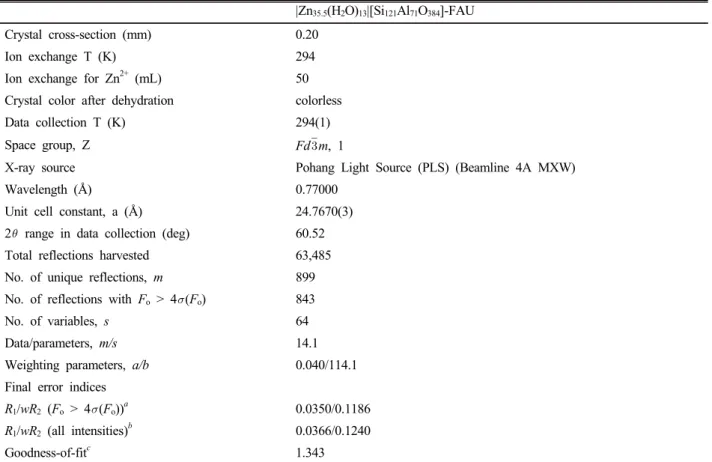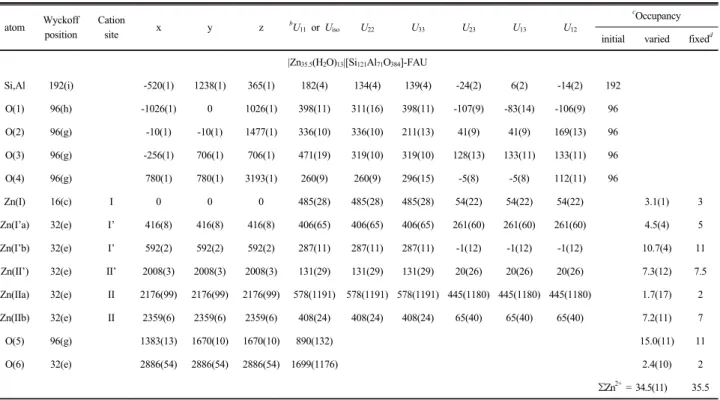Partially Dehydrated Fully Zn 2+ -exchanged Zeolite Y (FAU, Si/Al = 1.70) and Its Structure
Sung Man Seo
1, Young Hun Kim
2, Seok Hee Lee
3*, and Woo Taik Lim
1*
1
Department of Applied Chemistry, Andong National University, Andong 760-749, Korea
2
Department of Environmental Engineering, Andong National University, Andong 760-749, Korea
3
Department of Science Education, Busan National University of Education, Busan 611-736, Korea
The crystal structure of partially dehydrated fully Zn
2+-exchanged zeolite Y was determined by X-ray diffraction techniques in the cubic space group Fd m at 294(1) K and refined to the final error indices R
1/wR
2= 0.035/0.119 for |Zn
35.5(H
2O)
13|[Si
121Al
71O
384]-FAU. About 35.5 Zn
2+ions per unit cell are found at six distinct positions; sites I, I’, a second I’, II’, II, and a second II. In sodalite cavities, the 11 water molecules coordinate to Zn(I’b) and/or Zn(II’) ions; each of two H
2O bonds to a Zn(IIb) in supercages. Two different Zn
2+positions near 6-oxygen ring are due to their Si-Al ordering in tetrahedral site by Si/Al ratio leading to the different kinds of 6-rings.
Key words: Zinc, Zeolite Y, Structure, Ion exchange, Dehydrated
Received : 2013. 2. 28 Accepted : 2013. 4. 10
*Corresponding author : Phone: +82548205454 Fax: +82548225452
E-mail:wtlim@andong.ac.kr (W.T.L.), Phone: +82515007243
Email: seok@bnue.ac.kr (S.H.L.)
Introduction
The effects of distribution and coordination geometry of cations in the zeolites have received a great deal of attention over the last decades for their catalytic properties.
Especially, zinc (Zn) has been used in industries as hydro- carbon catalyst (Chu, 1978; Rhee et al., 1983; Gairbekov et al., 1989) for the separation of hydrogen sulfide from fossil fuels (Brooks, 1990), isomerization of basic alkane (Brownscombe, 1991), hydrosulfurization of alcohols (Ziolek, 1992), decomposition of nitromethane (Blower et al., 1993), and conversion of butane into aromatics (Kumar et al., 1996).
The extensive hydrolysis of hydrated cation and over-exchange were observed in two structural studies of Zn
2+-exchanged zeolites X from an aqueous solution (Bae et al., 1999; Lee et al., 2000). A single crystal of dehydrated Zn
2+-exchanged zeolite X was prepared by flow method using 0.05 M Zn(NO
3)
2for 48 h at 353 K, followed by vacuum dehydration at 673 K and 1 × 10
-5Torr (Bae et al., 1999). In the structure of |Zn
46(HAlO
4)
8H
8| [Si
100Al
92O
384]-FAU (Si/Al = 1.09), over-exchange, framework dealumination, charge valance of framework,
and loss of long-range Si/Al ordering were seen; 56 Zn
2+ions were found per unit cell and eight nonframe- work aluminate ions were found at the center of sodalite cavities. Lee and Kim also studied a dehydrated Zn
2+-exchanged zeolite X, |Zn
46(ZnO)
8|[Si
100Al
92O
384]- FAU (Si/Al = 1.09), by single-crystal X-ray diffraction (Lee et al., 2000). The over-exchange of Zn(OH)
2had occurred in sodalite cavity; 54 Zn
2+ions were found per unit cell, eight more than needed to balance the negative charge of the zeolite framework.
The single-crystal structure of fully dehydrated Zn
2+-exchanged zeolite Y (FAU, Si/Al = 1.70), dehydrated at 673 K and 1 × 10
-6Torr, were determined by single-crystal synchrotron X-ray diffraction techniques by Seo et al. (Seo et al., 2011). In the structure of
|Zn
35.5|[Si
121Al
71O
384]-FAU, about 35.5 Zn
2+ions per unit cell were found at an unusually large number of crystallographic distinct positions, six.
This study was done to determine the structure of partially dehydrated fully Zn
2+-exchanged zeolite Y and to investigate the distribution and coordination geometry of cations and water molecules in the framework.
Materials and Methods
Large clear colorless octahedral single crystals of
sodium zeolite Y, |Na
71|[Si
121Al
71O
384]-FAU (Si/Al =
1.70), with a diameter up to 0.20 mm were prepared by
Table 1. Summary of experimental and crystallographic data
|Zn
35.5(H
2O)
13|[Si
121Al
71O
384]-FAU
Crystal cross-section (mm) 0.20
Ion exchange T (K) 294
Ion exchange for Zn
2+(mL) 50
Crystal color after dehydration colorless
Data collection T (K) 294(1)
Space group, Z Fd m, 1
X-ray source Pohang Light Source (PLS) (Beamline 4A MXW)
Wavelength (Å) 0.77000
Unit cell constant, a (Å) 24.7670(3)
2 range in data collection (deg) 60.52
Total reflections harvested 63,485
No. of unique reflections, m 899
No. of reflections with F
o> 4 (F
o) 843
No. of variables, s 64
Data/parameters, m/s 14.1
Weighting parameters, a/b 0.040/114.1
Final error indices
R
1/wR
2(F
o> 4 (F
o))
a0.0350/0.1186 R
1/wR
2(all intensities)
b0.0366/0.1240
Goodness-of-fit
c1.343
a
R
1= Ʃ|F
o-|F
c||/ƩF
oand wR
2= [Ʃw(F
o2-F
c2)
2/Ʃw(F
o2)
2]
1/2; R
1and wR
2are calculated using only the reflections for which F
o> 4 (F
o).
bR
1and wR
2are calculated using all unique reflections measured.
cGoodness-of-fit = (Ʃw(F
o2-F
c2)
2/(m-s))
1/2, where m is the number of unique reflections and s is the number of variables, respectively.
Lim et al. (Lim et al., 2007). To prepare Zn
2+-exchanged zeolite Y (Zn-Y), 0.1 g of hydrated Na-Y was mixed with 10 mL of 0.05 M Zn(NO
3)
2(Aldrich, 99.999%) in 15-mL conical tube and then the mixture was stirred for 4 h at 294 K (Seo et al., 2011). The ion-exchange procedure was repeated 5 times with the fresh Zn(NO
3)
2solution. The product was dried at 323 K for 1 day. One of these, a hydrated Zn
2+-exchanged zeolite Y crystal, was lodged in a fine Pyrex capillary and dehydrated at 673 K and 1 × 10
-6Torr for 1 h.
Synchrotron X-ray diffraction data was collected for the crystal at 294(1) K using an ADSC Quantum210 detector at Beamline 4A MXW at the Pohang Light Source. Crystal evaluation and data collection were done with a detector-to-crystal distance of 60 mm.
Preliminary cell constants and an orientation matrix were determined from 72 sets of frames collected at a scan interval of 5° with an exposure time of 1 s per frame.
The basic scale file was prepared using the HKL2000 program (Otwinowski et al., 1997). The reflections were successfully indexed by the automated indexing
routine of the DENZO program (Otwinowski et al., 1997). The diffraction data were harvested by collecting 72 sets of frames with 5° scans with an exposure time of 1 s per frame. These highly redundant data sets were corrected for Lorentz and polarization effects, and a very small correction for crystal decay was applied. The space group Fd m, standard for zeolite Y, was determined by the XPREP program (Bruker-AXS, 2001).
A summary of the experimental and crystallographic data is presented in Table 1.
Full-matrix least-squares refinement using SHELXL97
(Sheldrick, 1997) was done on F
2using all data for
crystal. The refinement was initiated with the atomic para-
meters of the framework atoms [(Si,Al), O(1), O(2),
O(3), and O(4)] in fully dehydrated |Zn
35.5|[Si
121Al
71O
384]-
FAU (Seo et al., 2011). The initial refinement used
anisotropic thermal parameters and converged to the
high error indices R
1/wR
2= 0.37/0.81. All shifts in the
final cycles of refinement were less than 0.1% of their
corresponding estimated standard deviations. The final
error indices are given in Table 1. Structural parameters
Table 2. Positional, thermal, and occupancy parameters
aatom Wyckoff position
Cation
site x y z bU11 or Uiso U22 U33 U23 U13 U12
cOccupancy initial varied fixedd
|Zn35.5(H2O)13|[Si121Al71O384]-FAU
Si,Al 192(i) -520(1) 1238(1) 365(1) 182(4) 134(4) 139(4) -24(2) 6(2) -14(2) 192
O(1) 96(h) -1026(1) 0 1026(1) 398(11) 311(16) 398(11) -107(9) -83(14) -106(9) 96
O(2) 96(g) -10(1) -10(1) 1477(1) 336(10) 336(10) 211(13) 41(9) 41(9) 169(13) 96
O(3) 96(g) -256(1) 706(1) 706(1) 471(19) 319(10) 319(10) 128(13) 133(11) 133(11) 96
O(4) 96(g) 780(1) 780(1) 3193(1) 260(9) 260(9) 296(15) -5(8) -5(8) 112(11) 96
Zn(I) 16(c) I 0 0 0 485(28) 485(28) 485(28) 54(22) 54(22) 54(22) 3.1(1) 3
Zn(I’a) 32(e) I’ 416(8) 416(8) 416(8) 406(65) 406(65) 406(65) 261(60) 261(60) 261(60) 4.5(4) 5
Zn(I’b) 32(e) I’ 592(2) 592(2) 592(2) 287(11) 287(11) 287(11) -1(12) -1(12) -1(12) 10.7(4) 11
Zn(II’) 32(e) II’ 2008(3) 2008(3) 2008(3) 131(29) 131(29) 131(29) 20(26) 20(26) 20(26) 7.3(12) 7.5
Zn(IIa) 32(e) II 2176(99) 2176(99) 2176(99) 578(1191) 578(1191) 578(1191) 445(1180) 445(1180) 445(1180) 1.7(17) 2
Zn(IIb) 32(e) II 2359(6) 2359(6) 2359(6) 408(24) 408(24) 408(24) 65(40) 65(40) 65(40) 7.2(11) 7
O(5) 96(g) 1383(13) 1670(10) 1670(10) 890(132) 15.0(11) 11
O(6) 32(e) 2886(54) 2886(54) 2886(54) 1699(1176) 2.4(10) 2
ƩZn2+ = 34.5(11) 35.5
a
Positional parameters × 10
4and thermal parameters × 10
4are given. Numbers in parentheses are the estimated standard deviations in the units of the least significant figure given for the corresponding parameter.
bThe anisotropic temperature factor is exp[-2π
2a-2(U
11h2+ U
22k2+ U
33l2+ 2U
23kl +2U
13hl + 2U12hk)]. cOccupancy factors are given as the number of atoms or ions per unit cell.
dThese integral values were used only in the presentation of this work, to facilitate readability.
Table 3. Selected interatomic distances (Å) and angles (deg)
aDistances Angles
(Si,Al)-O(1) 1.6312(12) O(1)-(Si,Al)-O(2) 112.65(12) (Si,Al)-O(2) 1.6773(12) O(1)-(Si,Al)-O(3) 108.81(15) (Si,Al)-O(3) 1.6956(15) O(1)-(Si,Al)-O(4) 112.56(14) (Si,Al)-O(4) 1.6322(10) O(2)-(Si,Al)-O(3) 104.98(14) Mean (Si,Al) 1.6591 O(2)-(Si,Al)-O(4) 106.74(13) O(3)-(Si,Al)-O(4) 110.85(15) Zn(I)-O(3) 2.552(3)
Zn(I’a)-O(3) 1.949(4) (Si,Al)-O(1)-(Si,Al) 143.25(23) Zn(I’b)-O(3) 2.138(5) (Si,Al)-O(2)-(Si,Al) 135.28(19) Zn(I’b)-O(5) 1.98(3) (Si,Al)-O(3)-(Si,Al) 128.58(19) Zn(II’)-O(2) 2.195(5) (Si,Al)-O(4)-(Si,Al) 148.50(20) Zn(II’)-O(5) 2.07(3)
Zn(IIa)-O(2) 2.098(7) O(3)-Zn(I)-O(3) 82.60(12), 97.40(12) Zn(IIb)-O(2) 2.249(9) O(3)-Zn(I’a)-O(3) 119.55(22) Zn(IIb)-O(6) 2.26(23) O(3)-Zn(I’b)-O(3) 104.0(3)
O(3)-Zn(I’b)-O(5) 97.7(6), 144.4(10) O(5)-Zn(I’b)-O(5) 51.1(17) O(2)-Zn(II’)-O(2) 110.9(3) O(2)-Zn(II’)-O(5) 87.9(9), 116.89(5) O(2)-Zn(IIa)-O(2) 119.8(7) O(2)-Zn(IIb)-O(2) 107.1(6) O(2)-Zn(IIb)-O(6) 111.7(6)
a


![Fig. 3. Stereoview of a representative supercage in partially dehydrated |Zn 35.5 (H 2 O) 13 |[Si 121 Al 71 O 384 ]-FAU](https://thumb-ap.123doks.com/thumbv2/123dokinfo/5511361.456290/4.892.467.803.470.638/fig-stereoview-representative-supercage-partially-dehydrated-zn-fau.webp)